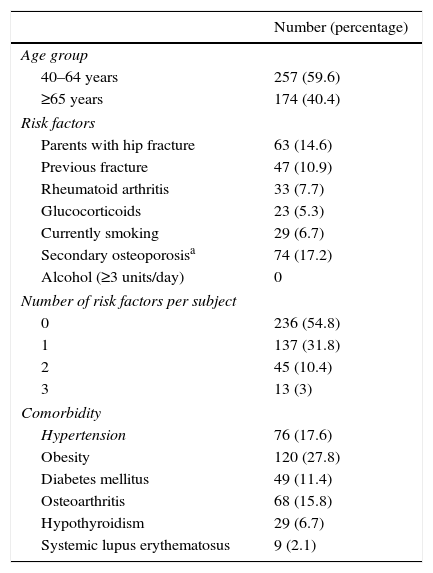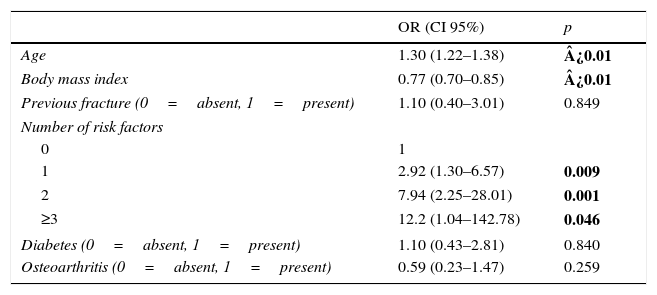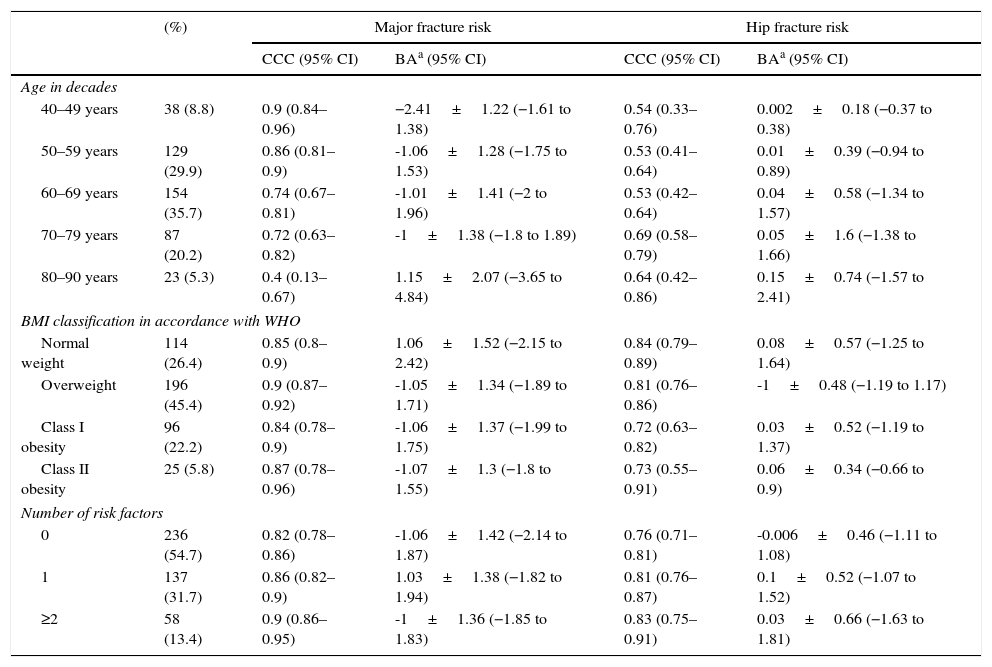The use of FRAX without the inclusion of bone mineral density (FRAX-BMI) may be useful in clinical practice to identify patients at high risk of fracture and inform treatment decisions, but its usefulness is debated. The aim of the study is to evaluate the agreement between the risk of fracture calculated by FRAX with or without bone mineral density (BMD).
Patients and methodsA cross-sectional study was conducted with 431 women (40–90 years) without treatment. The concordance of the probability of fracture was assessed by the concordance correlation coefficient (CCC), and by Bland–Altman method. The kappa index was used to evaluate the agreement between treatment indications.
ResultsThe difference between the risks of a major osteoporosis fracture (MOFR) was 1.02±1.40% (95% CI −2 to 1.90) and −0.03±0.51% (95% CI −1.18 to 1.32) for the hip fracture risk (HFR). Agreement between MOFR and HFR FRAX scores was good (CCC 0.879, 95% CI 0.85–0.90 and CCC 0.821, 95% CI 0.79–0.85, respectively). The correlation between BMD of the femoral neck and fracture risk calculated by FRAX-BMI was a moderate, MOFR (r=−0.55, p<0.001) and HFR (r=−0.54, p<0.001). The agreement between the recommendations of treatment was 87% (kappa 0.61).
ConclusionsThe good agreement between the risk of fracture obtained suggests that FRAX-BMI allows us to provide an estimate of risk in most cases.
El empleo del FRAX sin la inclusión de la densidad mineral ósea (FRAX-BMI) puede ser útil en la práctica clínica para identificar a los pacientes con riesgo elevado de fractura e informar sobre las decisiones de tratamiento, aunque su utilidad es motivo de debate. El objetivo del estudio es evaluar la concordancia entre el FRAX con y sin inclusión de la densidad mineral ósea (DMO).
Pacientes y métodosEstudio trasversal que incluyó 431 mujeres entre 40–90 años sin tratamiento previo. La concordancia de la probabilidad de fractura fue evaluada mediante el coeficiente de correlación y concordancia (CCC), y mediante el método de Bland-Altman. Se empleó el índice de kappa para evaluar la concordancia entre las indicaciones de tratamiento.
ResultadosLa diferencia entre el riesgo de fractura osteoporótica principal (RFP) fue 1,02±1,40% (IC 95% −2 a 1,90) y de −0,03±0,51% (IC 95% −1,18 a 1,32) para el riesgo de fractura de cadera (RFC). Los resultados del CCC demostraron una buena concordancia, para el RFP fue de 0,879 (IC 95% 0,85-0,90), y de 0,821 (IC 95% 0,79-0,85) para el RFC. Existió una correlación moderada entre el riesgo de fractura obtenida con el FRAX-BMI y la DMO del cuello femoral, RFM (r=−0,55, p<0,001) y RFC (r=−0,54, p<0,001). El acuerdo entre las recomendaciones de tratamiento fue del 87% (kappa 0,61).
ConclusionesLa buena concordancia entre el riesgo de fractura obtenido evidencia que el FRAX-BMI nos permite brindar una estimación del riesgo en la mayoría de los casos.












